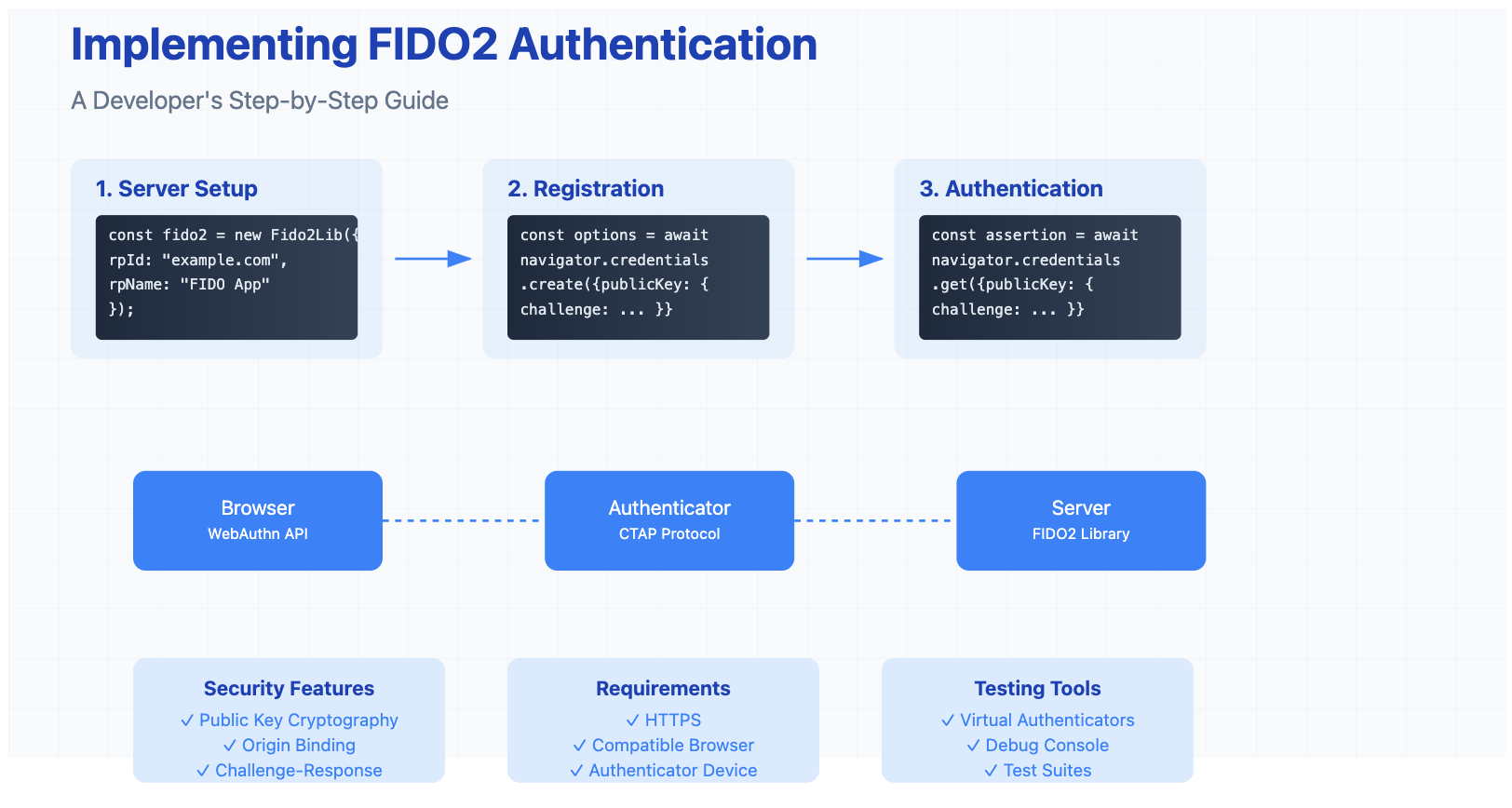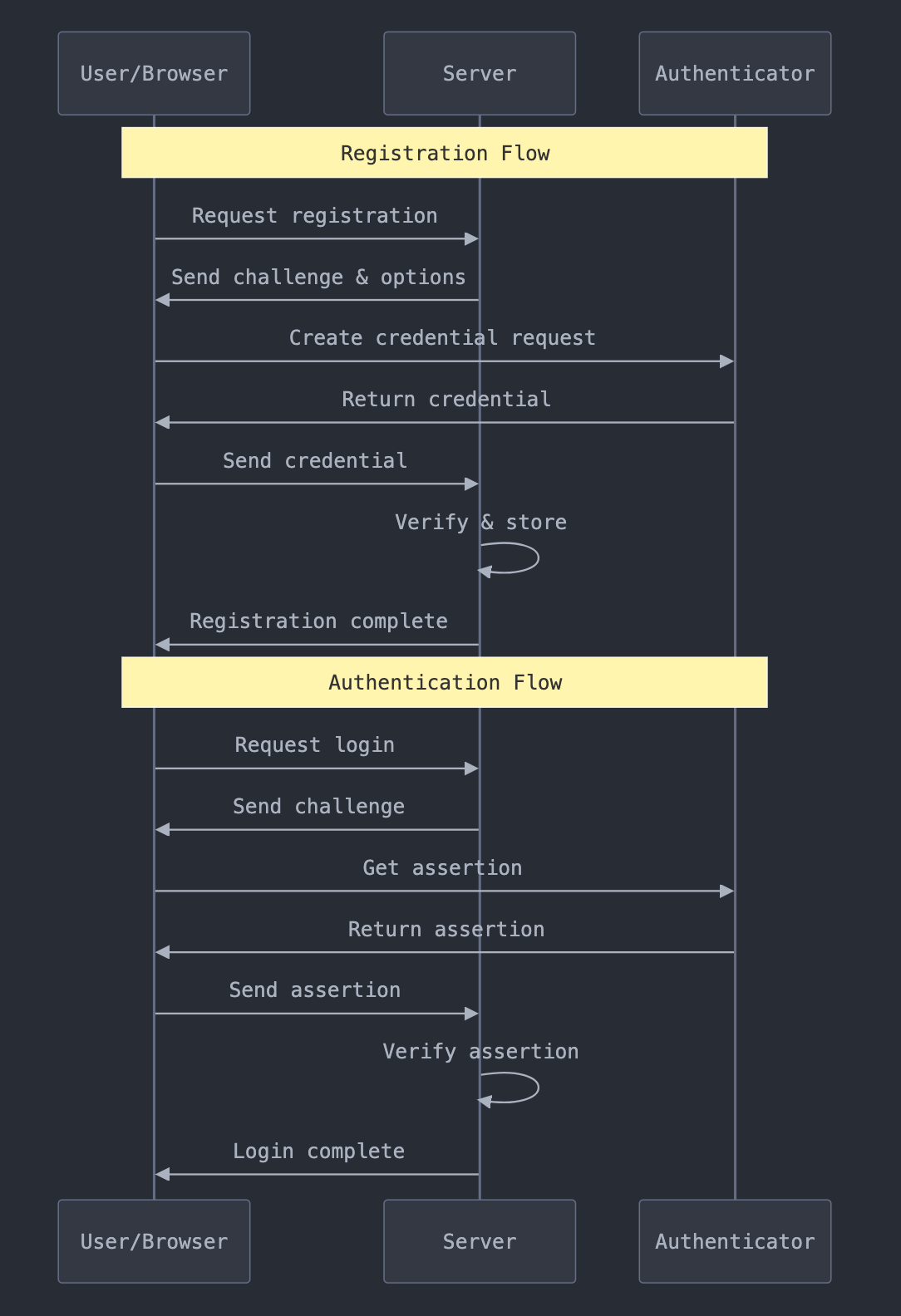Source: securityboulevard.com – Author: Deepak Gupta – Tech Entrepreneur, Cybersecurity Author
- Intro
- Why FIDO2?
- Implementation Overview
- Step-by-Step Guide
- Common Challenges & Solutions
- Testing Your Implementation
- Security Best Practices
Introduction to FIDO2 Authentication

FIDO2 is the latest set of specifications from the FIDO Alliance, aiming to enable passwordless authentication. It comprises two main components:
- WebAuthn API: A web standard published by the World Wide Web Consortium (W3C) that allows web applications to use public-key cryptography instead of passwords.
- Client to Authenticator Protocol (CTAP): A protocol that enables an external authenticator (like a hardware security key) to communicate with the client (like a web browser).
Key Benefits of FIDO2:
- Enhanced Security: Uses asymmetric cryptography, reducing the risk of credential theft.
- Improved User Experience: Eliminates the need for passwords, making authentication seamless.
- Phishing Resistance: Credentials are bound to specific origins, mitigating phishing attacks.
Why FIDO2?
Before diving into the implementation, let’s understand why FIDO2 is worth your time:
✅ No More Password Headaches
- Zero password storage
- No reset workflows needed
- Reduced support costs
✅ Superior Security
- Phishing-resistant
- Uses public key cryptography
- Eliminates credential database risks
✅ Better User Experience
- Fast biometric authentication
- No passwords to remember
- Works across devices
Implementation Overview
Here’s what we’ll build:
- User registration with FIDO2 credentials
- Passwordless login using those credentials
- Secure session management

What You’ll Need
// Required packages for Node.js npm install fido2-lib express body-parser Hardware Requirements
- Authenticator Devices: FIDO2-compatible security keys (e.g., YubiKey 5 Series) or biometric devices like fingerprint scanners.
- Development Machine: A computer capable of running a web server and accessing the internet.
- Test Devices: Multiple browsers and devices for cross-platform testing.
Software Requirements
- Programming Language: Knowledge of JavaScript for client-side and a server-side language like Node.js, Python, or Java.
- Web Server: Apache, Nginx, or any server capable of handling HTTPS requests.
- Databases: MySQL, PostgreSQL, MongoDB, or any database for storing user credentials.
- Libraries and Frameworks:
- Client-Side: Support for the WebAuthn API.
- Server-Side: FIDO2 server libraries compatible with your programming language.
Dependencies and Tools
- SSL Certificates: HTTPS is required for WebAuthn.
- Browser Support: Latest versions of Chrome, Firefox, Edge, or Safari.
- Development Tools: Code editor (e.g., Visual Studio Code), Postman for API testing.
Basic Architecture
┌──────────────┐ ┌──────────────┐ ┌──────────────┐ │ │ │ │ │ │ │ Browser │ ←──► │ Server │ ←──► │ Database │ │ (WebAuthn) │ │ (FIDO2Lib) │ │ │ │ │ │ │ │ │ └──────────────┘ └──────────────┘ └──────────────┘ 1. Server Setup
First, let’s set up our Express server with FIDO2 capabilities:
const express = require('express'); const { Fido2Lib } = require('fido2-lib'); const app = express(); // Initialize FIDO2 const f2l = new Fido2Lib({ timeout: 60000, rpId: "example.com", rpName: "FIDO Example App", challengeSize: 32, attestation: "none" }); app.use(express.json()); 2. Registration Endpoint
Create an endpoint to start the registration process:
app.post('/auth/register-begin', async (req, res) => { try { const user = { id: crypto.randomBytes(32), name: req.body.username, displayName: req.body.displayName }; const registrationOptions = await f2l.attestationOptions(); // Add user info to the options registrationOptions.user = user; registrationOptions.challenge = Buffer.from(registrationOptions.challenge); // Store challenge for verification req.session.challenge = registrationOptions.challenge; req.session.username = user.name; res.json(registrationOptions); } catch (error) { res.status(400).json({ error: error.message }); } }); 3. Client-Side Registration
Here’s the frontend JavaScript to handle registration:
async function registerUser() { // 1. Get registration options from server const response = await fetch('/auth/register-begin', { method: 'POST', headers: { 'Content-Type': 'application/json' }, body: JSON.stringify({ username: '[email protected]' }) }); const options = await response.json(); // 2. Create credentials using WebAuthn const credential = await navigator.credentials.create({ publicKey: { ...options, challenge: base64ToBuffer(options.challenge), user: { ...options.user, id: base64ToBuffer(options.user.id) } } }); // 3. Send credentials to server await fetch('/auth/register-complete', { method: 'POST', headers: { 'Content-Type': 'application/json' }, body: JSON.stringify({ id: credential.id, rawId: bufferToBase64(credential.rawId), response: { attestationObject: bufferToBase64( credential.response.attestationObject ), clientDataJSON: bufferToBase64( credential.response.clientDataJSON ) } }) }); } // Helper functions function bufferToBase64(buffer) { return btoa(String.fromCharCode(...new Uint8Array(buffer))); } function base64ToBuffer(base64) { return Uint8Array.from(atob(base64), c => c.charCodeAt(0)); } 4. Authentication Flow
Server-side authentication endpoint:
app.post('/auth/login-begin', async (req, res) => { try { const assertionOptions = await f2l.assertionOptions(); // Get user's registered credentials from database const user = await db.getUser(req.body.username); assertionOptions.allowCredentials = user.credentials.map(cred => ({ id: cred.credentialId, type: 'public-key' })); req.session.challenge = assertionOptions.challenge; req.session.username = req.body.username; res.json(assertionOptions); } catch (error) { res.status(400).json({ error: error.message }); } }); Client-side authentication:
async function loginUser() { // 1. Get authentication options const response = await fetch('/auth/login-begin', { method: 'POST', headers: { 'Content-Type': 'application/json' }, body: JSON.stringify({ username: '[email protected]' }) }); const options = await response.json(); // 2. Get assertion from authenticator const assertion = await navigator.credentials.get({ publicKey: { ...options, challenge: base64ToBuffer(options.challenge), allowCredentials: options.allowCredentials.map(cred => ({ ...cred, id: base64ToBuffer(cred.id) })) } }); // 3. Verify with server await fetch('/auth/login-complete', { method: 'POST', headers: { 'Content-Type': 'application/json' }, body: JSON.stringify({ id: assertion.id, rawId: bufferToBase64(assertion.rawId), response: { authenticatorData: bufferToBase64( assertion.response.authenticatorData ), clientDataJSON: bufferToBase64( assertion.response.clientDataJSON ), signature: bufferToBase64( assertion.response.signature ) } }) }); } Common Challenges & Solutions
1. Browser Compatibility
// Check if WebAuthn is supported if (!window.PublicKeyCredential) { console.log('WebAuthn not supported'); // Fall back to traditional authentication return; } // Check if user verifying platform authenticator is available const available = await PublicKeyCredential.isUserVerifyingPlatformAuthenticatorAvailable(); if (!available) { console.log('Platform authenticator not available'); // Consider security key instead } 2. Error Handling
// Client-side error handling try { const credential = await navigator.credentials.create({/*...*/}); } catch (error) { switch (error.name) { case 'NotAllowedError': console.log('User declined to create credential'); break; case 'SecurityError': console.log('Origin not secure'); break; default: console.error('Unknown error:', error); } } 3. Base64 URL Encoding
function base64UrlEncode(buffer) { const base64 = bufferToBase64(buffer); return base64.replace(/+/g, '-') .replace(///g, '_') .replace(/=/g, ''); } Testing Your Implementation
1. Basic Test Suite
describe('FIDO2 Authentication', () => { it('should generate registration options', async () => { const response = await fetch('/auth/register-begin', { method: 'POST', headers: { 'Content-Type': 'application/json' }, body: JSON.stringify({ username: '[email protected]' }) }); const options = await response.json(); expect(options).toHaveProperty('challenge'); expect(options).toHaveProperty('rp'); expect(options.rp.name).toBe('FIDO Example App'); }); }); 2. Virtual Authenticator Testing
// Using Chrome's Virtual Authenticator Environment const virtualAuthenticatorOptions = { protocol: 'ctap2', transport: 'internal', hasResidentKey: true, hasUserVerification: true, isUserConsenting: true }; const authenticator = await driver.addVirtualAuthenticator( virtualAuthenticatorOptions ); Security Best Practices
- Always Use HTTPS
if (window.location.protocol !== 'https:') { throw new Error('FIDO2 requires HTTPS'); } - Validate Origin
const expectedOrigin = 'https://example.com'; const clientDataJSON = JSON.parse( new TextDecoder().decode(credential.response.clientDataJSON) ); if (clientDataJSON.origin !== expectedOrigin) { throw new Error('Invalid origin'); } - Challenge Verification
if (!timingSafeEqual( storedChallenge, credential.response.challenge )) { throw new Error('Challenge mismatch'); } Production Checklist
✅ HTTPS configured
✅ Error handling implemented
✅ Browser support detection
✅ Backup authentication method
✅ Rate limiting enabled
✅ Logging system in place
✅ Security headers configured
Next Steps
- Implement user presence verification
- Add transaction confirmation
- Set up backup authentication methods
- Configure audit logging
- Implement rate limiting
Resources:
Need help? Join Discord community for support.
*** This is a Security Bloggers Network syndicated blog from Meet the Tech Entrepreneur, Cybersecurity Author, and Researcher authored by Deepak Gupta – Tech Entrepreneur, Cybersecurity Author. Read the original post at: https://guptadeepak.com/implementing-fido2-authentication-a-developers-step-by-step-guide/
Original Post URL: https://securityboulevard.com/2024/12/implementing-fido2-authentication-a-developers-step-by-step-guide/
Category & Tags: Identity & Access,Security Bloggers Network,Authentication,Best Practices,Digital Identity,FIDO,iam,Password,passwordless – Identity & Access,Security Bloggers Network,Authentication,Best Practices,Digital Identity,FIDO,iam,Password,passwordless
Views: 14




















































